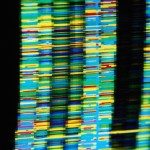Link to Pubmed [PMID] – 17074886
J. Cell Biol. 2006 Nov;175(3):389-400
In eukaryotic nuclei, DNA is wrapped around a protein octamer composed of the core histones H2A, H2B, H3, and H4, forming nucleosomes as the fundamental units of chromatin. The modification and deposition of specific histone variants play key roles in chromatin function. In this study, we established an in vitro system based on permeabilized cells that allows the assembly and exchange of histones in situ. H2A and H2B, each tagged with green fluorescent protein (GFP), are incorporated into euchromatin by exchange independently of DNA replication, and H3.1-GFP is assembled into replicated chromatin, as found in living cells. By purifying the cellular factors that assist in the incorporation of H2A-H2B, we identified protein phosphatase (PP) 2C gamma subtype (PP2Cgamma/PPM1G) as a histone chaperone that binds to and dephosphorylates H2A-H2B. The disruption of PP2Cgamma in chicken DT40 cells increased the sensitivity to caffeine, a reagent that disturbs DNA replication and damage checkpoints, suggesting the involvement of PP2Cgamma-mediated histone dephosphorylation and exchange in damage response or checkpoint recovery in higher eukaryotes.

